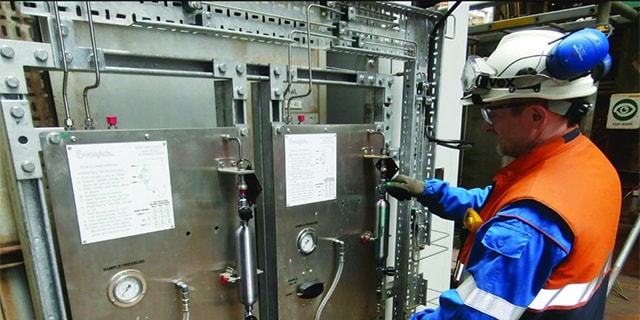How to Select the Right Sample Preconditioning Module

How to Select the Right Sample Preconditioning Module
Randy Rieken
When performing sample analysis in an analytical sampling system, an operator may need to precondition the sample first, before it reaches the sample conditioning system near the analyzer. When this step is necessary for sample analysis, selecting the right sample preconditioning module becomes a critical decision.
The preconditioning module choice is contingent on the type of sample-transport system used and the sample’s current phase—a gas or a liquid. Depending on these circumstances, there are two common design options for sample preconditioning:
- A field station module installed near the tap
- A fast-loop module installed near the analyzer
Sample-Transport Systems
First, it is necessary to determine which sample-transport system will be used within your sampling system. There are two common sample-transport systems used in analytical instrumentation applications.
A single-line system transports a sample to the analyzer location and continues on to the final disposal point. Single-line transport systems are commonly used with gas samples. A single-line system with a field station module is most likely needed if gas samples are preconditioned before they enter the sample transport line.
A fast-loop system, on the other hand, transports a sample to the analyzer locations, where only a small amount of flow passes through the analyzer and the rest returns to the process return tap. Fast-loop systems are common for liquid samples, but there are situations where a fast-loop should be used to safely transport a gaseous sample. Typically, fast-loop systems will use a fast-loop module to precondition the sample after it reaches the analyzer location.
Field Station Modules vs. Fast-Loop Modules
Once the sample-transport system is determined, a selection must be made regarding the proper sample preconditioning module. You may decide to use a field station module, a fast-loop module, or neither. The primary distinction between the two modules is when the sample is preconditioned—either before it enters the sample transport line (field station module) or after it arrives at the analyzer location (fast-loop module). It is important to note that a sampling system will rarely use both modules.
Figure 1: A field station module mounted in a single line transport system.
Field station modules are often available as subassemblies containing devices that filter the sample, vaporize a liquid sample or reduce the pressure of a gas sample. As seen above in Figure 1, a field station module will precondition a sample prior to passing into the sample transport line. Field station modules have the ability to:
- Remove unwanted solids or liquids from the stream.
- Change the pressure or temperature of the sample.
- Change the state of the sample through vaporization or condensation.
- Allow calibration gas entry.
Figure 2: A fast-loop module mounted in a fast-loop system.
Most fast-loop modules are used for liquid samples, although fast-loops are becoming more popular for gas samples as well. In most cases, fast-loop modules are available as subassemblies that incorporate devices that control the flow rate and filter the analyzed sample. Figure 2 demonstrates how a fast-loop module preconditions the sample after it arrives at the analyzer location.
Since a fast-loop almost never preconditions samples in the field, a field station is not needed. Only a small amount of flow is sent to the analyzer, leaving the rest of the flow unconditioned and sent back to the sample return line.
Liquid Sample Preconditioning Considerations
Liquid samples are most commonly preconditioned using a fast-loop module simply because liquids are often too difficult to dispose of or destroy. Due to environmental concerns related to sample dumping, fast-loop modules help solve for potentially hazardous waste. Liquids also contain more mass per volumetric flow, causing these samples to be more valuable than most gas samples. With fast-loop modules, uncontaminated liquids are often looped back into the sampling system.
Gas Sample Preconditioning Considerations
As explained above, gas samples can be preconditioned using either a field station module or a fast-loop module. Traditionally, a field station module is used to not only precondition the gas sample, but to also reduce its pressure prior to transportation to the analyzer location. Reducing gas pressure improves response time—allowing the gas to move twice as fast. A gaseous sample travelling at a lower pressure is safer.
However, there may be situations where a high pressure must be preserved. The sample measurement may be required to be at full process pressure, or the analyzer needs high sample pressure to measure the ppm or ppb levels of the gaseous sample. In these circumstances, the issue of disposal must remain top of mind—especially if these gaseous samples include carbon or sulfur. Such samples should instead use a fast-loop to send the majority of the sample back to the return line.
Understanding the conditions of both your sampling system and your sample will help you determine which sample preconditioning module is right for your system operations. To ensure your plant or facility consistently receives representative samples and accurate analytical results, consider registering for Swagelok’s Process Analyzer Sampling System (PASS) Subsystem Training course. Experienced sampling system engineers and industry professionals will learn how to understand complex system subassemblies, such as sample preconditioning modules.
Related Articles

Sampling Systems: 8 Common Process Analyzer Accuracy Challenges
Sampling systems expert and veteran industry instructor Tony Waters offers plant managers and design engineers tested ways to identify and resolve 8 common challenges for process analyzer accuracy.

How to Calibrate an Analyzer in an Analytical Instrumentation System
Calibration is an important process and an absolute requirement in analytical systems. Care must be taken when performing this process—error can be introduced. Learn how to calibrate your analyzer to ensure an accurate analytical measurement.

Avoiding Classic Liquid and Gas Sampling System Mistakes
Whether you’re working with a gas or a liquid sample, common sampling system mistakes often occur during initial design. Learn how to avoid classic sampling mistakes and get better gas and liquid samples every time with design tips from Swagelok.



